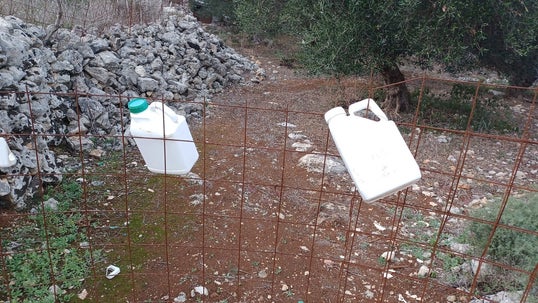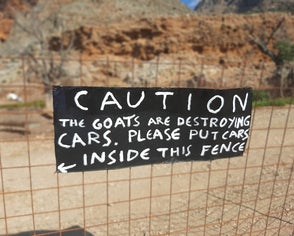When you walk (or bike or drive) through the Cretan landscape you see some typical, weird things! Some things you can probably figure out yourself, but there are also others that make you wonder why or what is that for? So, some explanations in this article!
1. Why are the tree trunks painted white?
When you walk around Crete you see that many tree trunks are painted white. It looks like decoration, which is partly true and often you see white-painted tree trunks around churches and terraces. There are some other reasons why people do this!
“Decoration”
The tradition of painting the tree trunks and other objects has its roots in ancient times. It is connected with the traditional architecture and they do it especially during the beginning of the spring. Especially before Easter, the Cretans used to paint their houses to celebrate the most important religious Greek event. They paint also the dry stone walls, the curbs and, of course, the tree trunks. The paint that people use is lime.
“Anti-bacteria”
Another reason is that the Greeks believe that the lime ensures that bacteria and vermin do not affect the trunk of the tree and protect it from woody insects and fungi. Despite its disinfecting properties, lime has no insecticidal or fungicidal action. For apple and pear trees, liming repels the female insects of Sesia myopiformis (in Europe known as the red-belted clearwing) to lay its eggs in the trunk.
“Cooling down”
Another reason why the trees are painted white has to do with the heat and the sun on Crete. The white paint helps to reflect the sun’s rays. For citrus trees and for trees whose bark is very thin, farmers use liming to protect them from sunburn. If the bark of a tree becomes too warm, it can burst open. Because of the white paint the bark does not crack open and the tree does not lose its juices. Some farmers also do so to prevent goats and sheep from eating the leaves and the bark of trees.

Painted eucalyptus trees at Vamos square

White washed orange trees

2. Why are bottles and stones hung on trees?
Very often in Crete you see usually bottles but also stones hanging on the trees. In particularly on mulberry trees! Often locals joke that bottles of raki grow in the trees! You usually see these trees in courtyards of houses, at car parks and at squares and cafes.


The bottles are hanging from the thin branches of mulberry trees (mouries in Greek) when the branch is still flexible. Due to the weight, the branch does not grow upward but horizontally. As the branches grow, they become stiffer and the tree will have a shape like umbrella. In spring, when the leaves begin to appear, the tree has transformed to a perfect natural umbrella for the sun. In this shape, it offers lots of shade!
In lots of places like hotels and squares, where you see many mulberry trees in a row, branches of the trees are connected and in this way you get natural shady arches!
3. Snails high up in the fences and plants, why?
Especially in the hot summer months you see on many places snails, especially the white garden snails (theba pisana) stuck in groups in fences and high up in the stem of plants or trunks.
Actually, the snails are hibernating (in summer this process is called "aestivation") and the snails congregate near the top of the plants to avoid the heat.
Also in this way snails overcome the high temperatures and the low levels of humidity in the summer. Higher up it will generally be cooler than on or near the ground, so the snails climb up the stem of leafless plants or trunks so as to avoid dying of dehydration. They hold on to the vegetal substrate creating epiphragm, which can be created in about 10 minutes. During the summer months, snails remain dormant, reducing their metabolism and heartbeat to half. Many animals employ this strategy to withstand harsh winter conditions, but in the case of the land snails here on Crete, they do so to survive the rigors of summer.


4. White plastic cannisters hanging on a tree or a fence!
When you walk along olive groves or orange groves, you see quite often white plastic canisters or bottles hanging in a tree or tied onto a fence. This is a warning that the field has been sprayed with Roundup (glyphosate-based herbicide) to kill the weeds in the field! It is obligatory to hang the bottles at your field as a warning! This product kills existing weeds and grass down to the root and prevents new weeds from growing for up to 4 months.


The weed killer glyphosate is controversial! The weed killer glyphosate is one of the most widely used weed killers in the world and is produced by Bayer. It is controversial because critics point to evidence of its potential impact on biodiversity and that it may cause cancer. But, just recently (15-11-2023), The European Union approved the use of this controversial herbicide glyphosate for another 10 years. There will be extra and new conditions and restrictions, the EU Commission has said. .
5. Again...plastic water bottles in olive trees
When you are walking in Crete through the olive groves, then surely some of you have noticed that often a plastic bottle is hung on the olive trees. Usually you see normal bottles for mineral water, sparkling water, or fresh drinks. When you see such bottles, you can assume that this is an organic olive cultivation. Why? The bottles contain a natural remedy against the olive fruit fly. This fly is very harmful to the olives and can affect the overall quality of the olive oil. This can cause the oil to be very acidic and smell musty.


Inside the bottles different baits are used to attract the flies such as Diammonium phosphate or vinegar (also wine vinegar) or hydrolysed proteins, usually in combination with insecticides to control this pest.
6. Small shrines or iconostasis along the road
Small shrines or kandylakia (καντηλάκια) or iconostasis are like miniature churches/chapels that can be seen throughout Greece, usually on the side of roads, often on a dangerous part or awkward corners and bends on the road, but sometimes too in the gardens of homes or even at the entrance to a restaurant.
Road accidents are mostly the reason for placing these shrines, in order to commemorate someone who has died in a tragic accident. Often though, they are placed as a promise and a gesture of thankfulness to a Saint. They celebrate miracles and those who survived dedicate a shrine (kandylaki) to their patron saint. Another reason for these shrines is a way to indicate that there is a monastery or church in vicinity, especially in less populated areas where the church might be completely out of sight.
These small shrines can be made of concrete, stone, metal, wood, marble or ceramic materials. Although they often look alike, each one is unique. Inside, they usually have icons, perhaps of a favourite family saint, and beeswax candles or votive lamps lit by olive oil. Some may even have a small hand censer for burning incense.




There might also be a photograph of a person or people, which is unfortunately an indication that those in the photo were killed.
In large cities, such as Athens and Thessaloniki, they are also used by passers-by as public prayer corners where they can stop and pray when the neighbouring church is closed. They may even have a small donation box.
Some shrines are the size of a child’s playhouse with space inside that is just large enough to hold small ceremonies. These can serve as private chapels on private property.
7. Millions of fences!
When you are walking on Crete you will notice it straight away: fences, many of them! Usually not fancy ones but the metal ones that are used to reinforce the concrete. The farmers build fences to protect their olive groves, gardens or vineyards from sheep and goats that eat everything. You will see those fences everywhere and not only around fields but even on very steep cliffs and canyons.
When you are walking on a dirt road or path and there is a fence - door it does not mean that you enter into a private area or that you are not allowed to pass. Someone has put the fence there to obstruct sheep entrance in the villages, vineyards, olive groves or pastures that belong to another shepherd. In these cases, open the door and after you pass close it again!
Most times a fence-door from one side is permanently tied with wires. At the other side there is a wire or a string. Untie the knot, open the door and close it the same way.
Never destroy or damage a fence-door. Always close the door that you open. If a door is permanently closed with wires or locked it means that the area is private. Never cut the wires, chains or locks with pliers.





Hopefully some things you have seen in the Cretan landscape are a bit clearer now! Perhaps you have some other questions or you have noticed some habits, strange or un-clarified things that you want to ask about! Write it in the comments!


Add comment
Comments
Very interesting, thankyou. Only one point though. In summer snails "aestivate", not "hybernate" which if they do it they do it in the winter.
Hello Leigh! Thanks for your comment, you are absolutely right! It's corrected!
Dat is een aardig lesje Griekse cultuur!
Well done!